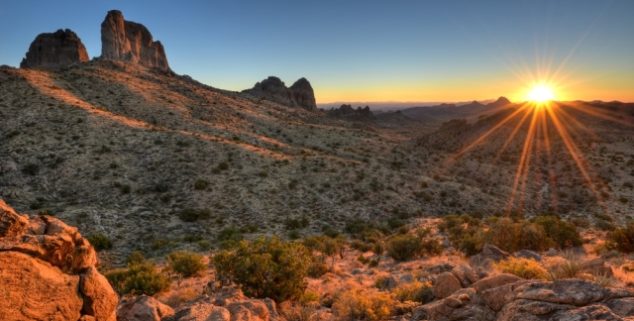Opinion
Clock ticking on desert protection
 Sunrise in the Mojave Desert, CAstle Peaks. (Photo: sierralara, via Shutterstock)
Sunrise in the Mojave Desert, CAstle Peaks. (Photo: sierralara, via Shutterstock)The window of opportunity is rapidly closing for Senate Leader Toni Atkins and the California Legislature to save the Mojave Desert from a company’s reckless plan to suck the water out from under one of the Earth’s driest places and sell it to water golf courses and suburban lawns as far away as Orange County.
Killed by Barack Obama and revived by Donald Trump, the water mining project by Cadiz, Inc., would dramatically overdraw the aquifer below the desert and almost certainly stop the flow of water to the springs that preserve the Mojave’s fragile biodiversity and contribute to its $370 million annual tourist industry.
The path that Cadiz has followed reflects the extent to which our political system is vulnerable to the influence of money. For more than two decades, Cadiz has shown extraordinary shrewdness and cynicism in exploiting the vulnerabilities and venality of California lawmakers, Republican and Democratic alike.
Federal scientists concluded that Cadiz would pump up to 25 times more water than is recharged.
The Cadiz Playbook opens with the Gray Davis administration and its current chapter is set in the State Senate.
In 2002, the first version of the Cadiz scheme was rejected, despite Cadiz’s fundraising connections to then-Gov. Davis, who flew around in Cadiz jets and accepted hundreds of thousands in campaign contributions.
In the subsequent 16 years, Cadiz continued to exploit the myriad flaws and foibles in our local, state, and federal environmental protection regimes.
In its second go, Cadiz eventually induced the San Bernardino County Board of Supervisors — with the help of more than $100,000 in well-timed campaign contributions — to cede their lead-agency status for the California Environmental Quality Act to the distant, tiny Santa Margarita Water District, which would be the main purchaser of the water.
Fortunately for Cadiz, an Environmental Impact Report (EIR) is only as sound and impartial as the lead agency soliciting and approving it. Santa Margarita and the Cadiz corporation got exactly the EIR they wanted, which grossly inflated the groundwater basin’s recharge rate from rainfall, mischaracterized the hydrology of surrounding springs, and minimized the project’s potential ecological impacts.
In spite of these machinations, President Obama’s administration interceded to halt the big suck, affirming that a federal permit would be required. In light of federal scientists concluding that Cadiz would pump up to 25 times more water than is recharged, Obama’s action, for all intents and purposes, put the final nail in Cadiz’s coffin.
That is, until Donald Trump ascended to the presidency. Unfortunately for the Mojave, Trump nominated David Bernhardt, a Cadiz partner, as deputy secretary of the Interior Department. Predictably, the Trump administration backtracked, saying no federal permit was needed by Cadiz.
But the great state of California has one last hope to save the Mojave’s delicate desert ecosystem.
AB 1000, authored by Assemblymember Laura Friedman, would add a level of state environmental oversight much more difficult for Cadiz to suborn than the Trump administration and deep-red municipalities.
The bill looked set to sail through California’s conservation-friendly legislature, until Cadiz employed one of its oldest, most unseemly stratagems.
From the beginning, Cadiz has been fond of paying large consulting fees to close friends of key elected officials, and then leveraging their relationships to obtain support. In the early 2000s, Cadiz and its associates had plied Gov. Davis with more than $230,000 in campaign donations. They have been equally generous with former Assembly Speaker Antonio Villaraigosa. In 2005, Cadiz paid Susan Kennedy, the soon-to-be chief of staff to Arnold Schwarzenegger, $120,000 in consulting fees and walked away with the governor’s ringing endorsement.
As AB 1000 neared a floor vote in 2017, Cadiz retained former Assembly Speaker Fabián Nuñez, an old friend and mentor of Senate Leader Kevin de León and Sen. Ricardo Lara, and AB 1000 was subsequently blocked in the Senate. When Sen. Toni Atkins ascended to the office of Senate Leader earlier this year, Cadiz quickly hired her former chief of staff, Greg Campbell, to gain her ear.
Time is running out for action to pass legislation. Atkins, the most powerful woman in California, has a long history of environmental leadership.
Cadiz believes that Sen. Atkins will be the latest page in the Cadiz playbook. But I have faith that she will preserve the Mojave Desert for our children and grandchildren, and that together we can protect California’s precious natural resources from the Cadiz corporation and Donald Trump’s catastrophic environmental agenda.
—
Ed’s Note: Cody Petterson is president of San Diego County Democrats for Environmental Action.
Want to see more stories like this? Sign up for The Roundup, the free daily newsletter about California politics from the editors of Capitol Weekly. Stay up to date on the news you need to know.
Sign up below, then look for a confirmation email in your inbox.

Many thanks to Cody Petterson, for preparing this oustanding article !
STOP THE CADIZ PROJECT !